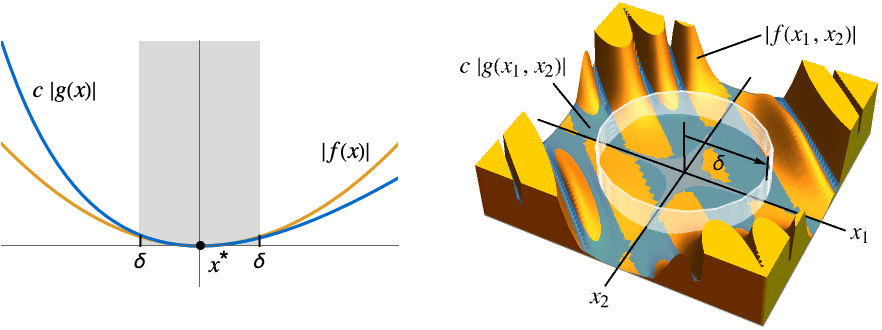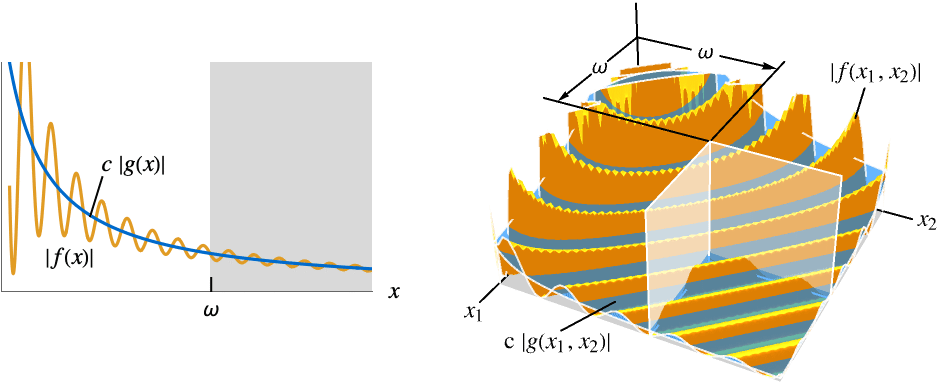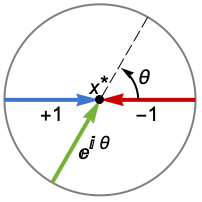AsymptoticEquivalent[f,g,xx*]
gives conditions for ![]() as xx*.
as xx*.
AsymptoticEquivalent[f,g,{x1,…,xn}{![]() ,…,
,…,![]() }]
}]
gives conditions for ![]() as {x1,…,xn}{
as {x1,…,xn}{![]() ,…,
,…,![]() }.
}.


AsymptoticEquivalent
AsymptoticEquivalent[f,g,xx*]
gives conditions for ![]() as xx*.
as xx*.
AsymptoticEquivalent[f,g,{x1,…,xn}{![]() ,…,
,…,![]() }]
}]
gives conditions for ![]() as {x1,…,xn}{
as {x1,…,xn}{![]() ,…,
,…,![]() }.
}.
Details and Options




- Asymptotic equivalent is also expressed as f is asymptotic to g and f is asymptotically equivalent to g. The point x* is often assumed from context.
- Asymptotic equivalent is an equivalence relation and means
![TemplateBox[{{{f, (, x, )}, -, {g, (, x, )}}}, Abs]<=cTemplateBox[{{g, (, x, )}}, Abs] TemplateBox[{{{f, (, x, )}, -, {g, (, x, )}}}, Abs]<=cTemplateBox[{{g, (, x, )}}, Abs]](Files/AsymptoticEquivalent.en/7.png) when x is near x* for all constants
when x is near x* for all constants  . It is a finer asymptotic equivalence relation than AsymptoticEqual.
. It is a finer asymptotic equivalence relation than AsymptoticEqual. - Typical uses include simple expressions for functions and sequences near some point. It is frequently used for asymptotic solutions to equations.
- For a finite limit point x* and {
 ,…,
,…, }:
}: -
AsymptoticEquivalent[f[x],g[x],xx*] for all  there exists
there exists  such that
such that ![0<TemplateBox[{{x, -, {x, ^, *}}}, Abs]<delta(c,x^*) 0<TemplateBox[{{x, -, {x, ^, *}}}, Abs]<delta(c,x^*)](Files/AsymptoticEquivalent.en/13.png) implies
implies ![TemplateBox[{{{f, (, x, )}, -, {g, (, x, )}}}, Abs]<=cTemplateBox[{{g, (, x, )}}, Abs] TemplateBox[{{{f, (, x, )}, -, {g, (, x, )}}}, Abs]<=cTemplateBox[{{g, (, x, )}}, Abs]](Files/AsymptoticEquivalent.en/14.png)
AsymptoticEquivalent[f[x1,…,xn],g[x1,…,xn],{x1,…,xn}{  ,…,
,…, }]
}]for all  there exists
there exists  such that
such that ![0<TemplateBox[{{{, {{{x, _, 1}, -, {x, _, {(, 1, )}, ^, *}}, ,, ..., ,, {{x, _, n}, -, {x, _, {(, n, )}, ^, *}}}, }}}, Norm]<delta(epsilon,x^*) 0<TemplateBox[{{{, {{{x, _, 1}, -, {x, _, {(, 1, )}, ^, *}}, ,, ..., ,, {{x, _, n}, -, {x, _, {(, n, )}, ^, *}}}, }}}, Norm]<delta(epsilon,x^*)](Files/AsymptoticEquivalent.en/19.png) implies
implies ![TemplateBox[{{{f, (, {{x, _, 1}, ,, ..., ,, {x, _, n}}, )}, -, {g, (, {{x, _, 1}, ,, ..., ,, {x, _, n}}, )}}}, Abs]<=cTemplateBox[{{g, (, x, )}}, Abs] TemplateBox[{{{f, (, {{x, _, 1}, ,, ..., ,, {x, _, n}}, )}, -, {g, (, {{x, _, 1}, ,, ..., ,, {x, _, n}}, )}}}, Abs]<=cTemplateBox[{{g, (, x, )}}, Abs]](Files/AsymptoticEquivalent.en/20.png)
- For an infinite limit point:
-
AsymptoticEquivalent[f[x],g[x],x∞] for all  there exists
there exists  such that
such that  implies
implies ![TemplateBox[{{{{f, (, x, )}, /, {g, (, x, )}}, -, 1}}, Abs]<=c TemplateBox[{{{{f, (, x, )}, /, {g, (, x, )}}, -, 1}}, Abs]<=c](Files/AsymptoticEquivalent.en/25.png)
AsymptoticEquivalent[f[x1,…,xn],g[x1,…,xn],{x1,…,xn}{∞,…,∞}] for all  there exists
there exists  such that
such that  implies
implies ![TemplateBox[{{{{f, (, {{x, _, 1}, ,, ..., ,, {x, _, n}}, )}, /, {g, (, {{x, _, 1}, ,, ..., ,, {x, _, n}}, )}}, -, 1}}, Abs]<=c TemplateBox[{{{{f, (, {{x, _, 1}, ,, ..., ,, {x, _, n}}, )}, /, {g, (, {{x, _, 1}, ,, ..., ,, {x, _, n}}, )}}, -, 1}}, Abs]<=c](Files/AsymptoticEquivalent.en/29.png)
- AsymptoticEquivalent[f[x],g[x],xx*] exists if and only if Limit[f[x]/g[x],xx*]1 when g[x] does not have an infinite set of zeros near x*.
- The following options can be given:
-
Assumptions $Assumptions assumptions on parameters Direction Reals direction to approach the limit point GenerateConditions Automatic generate conditions for parameters Method Automatic method to use PerformanceGoal "Quality" what to optimize - Possible settings for Direction include:
-
Reals or "TwoSided" from both real directions "FromAbove" or -1 from above or larger values "FromBelow" or +1 from below or smaller values Complexes from all complex directions Exp[ θ] in the direction 
{dir1,…,dirn} use direction diri for variable xi independently - DirectionExp[ θ] at x* indicates the direction tangent of a curve approaching the limit point x*.
- Possible settings for GenerateConditions include:
-
Automatic non-generic conditions only True all conditions False no conditions None return unevaluated if conditions are needed - Possible settings for PerformanceGoal include $PerformanceGoal, "Quality" and "Speed". With the "Quality" setting, Limit typically solves more problems or produces simpler results, but it potentially uses more time and memory.



Examples
open all close allBasic Examples (2)
Scope (10)
Compare functions that are not strictly positive:
Show that ![]() diverges at the same rate and with the same scale as
diverges at the same rate and with the same scale as ![]() at the origin:
at the origin:
Answers may be Boolean expressions rather than explicit True or False:
When comparing functions with parameters, conditions for the result may be generated:
By default, a two-sided comparison of the functions is made:
When comparing larger values of ![]() ,
, ![]() vanishes at the same rate as
vanishes at the same rate as ![]() :
:
The relationship fails for smaller values of ![]() :
:
Visualize the ratio of the two functions, showing it approaches 1 from above but not from below:
Functions like Sqrt may have the same relationship in both real directions along the negative reals:
If approached from above in the complex plane, the same relationship is observed:
However, approaching from below in the complex plane produces a different result:
This is due to a branch cut where the imaginary part of Sqrt reverses sign as the axis is crossed:
Hence, the relationship does not hold in the complex plane in general:
Visualize the quantity defining asymptotic equivalence approached from four principal complex directions:
Compare multivariate functions:
Visualize the norms of the two functions:
Options (9)
Assumptions (1)
Specify conditions on parameters using Assumptions:
Direction (5)
Equivalence at piecewise discontinuities:
Since it fails in one direction, the two-sided result is false as well:
Visualize the two functions and their ratio:
Equivalence at a pole is independent of the direction of approach:
Determine equivalence, approaching from different quadrants:
Approaching the origin from the first quadrant:
Approaching the origin from the second quadrant:
Approaching the origin from the right half-plane:
GenerateConditions (3)
Return a result without stating conditions:
This result is only valid if n>0:
Return unevaluated if the results depend on the value of parameters:
By default, conditions are generated that return a unique result:
By default, conditions are not generated if only special values invalidate the result:
With GenerateConditions->True, even these non-generic conditions are reported:
Applications (12)
Basic Applications (5)
Show that two monomials equivalent at infinity have the same power and coefficient:
Use this to show that two polynomials that are equivalent have the same leading monomial:
Visualize three pairs of asymptotically equivalent polynomials:
Show that two monomials in ![]() equivalent at infinity have the same power and coefficient:
equivalent at infinity have the same power and coefficient:
Use this to show that two polynomials in ![]() that are equivalent have the same leading monomial:
that are equivalent have the same leading monomial:
Visualize three pairs of asymptotically equivalent polynomials in ![]() :
:
Even though they are equal infinitely many times, ![]() consistently deviates from 1:
consistently deviates from 1:
Even though they are equal infinitely many times, ![]() consistently deviates from 1:
consistently deviates from 1:
Asymptotic Approximation (7)
A function ![]() approximates
approximates ![]() as
as ![]() with small relative error if
with small relative error if ![]() as
as ![]() . Show that
. Show that ![]() approximates
approximates ![]() with small relative error as
with small relative error as ![]() :
:
Show that ![]() approximates
approximates ![]() with small relative error as
with small relative error as ![]() :
:
But the preceding approximation does not have small absolute error:
Similarly, Stirling's formula ![]() approximation to
approximation to ![]() has small relative error as
has small relative error as ![]() :
:
If ![]() is a function and
is a function and ![]() an approximation to
an approximation to ![]() near
near ![]() , the approximation is asymptotic if
, the approximation is asymptotic if ![]() at
at ![]() . In other words, the approximation has small relative error. Show that
. In other words, the approximation has small relative error. Show that ![]() is an asymptotic approximation to
is an asymptotic approximation to ![]() at
at ![]() :
:
Show that ![]() is an asymptotic approximation to
is an asymptotic approximation to ![]() at
at ![]() :
:
However, ![]() is not an asymptotic approximation to
is not an asymptotic approximation to ![]() at
at ![]() :
:
Stirling's formula ![]() gives an asymptotic approximation to
gives an asymptotic approximation to ![]() as
as ![]() :
:
Show that ![]() is an asymptotic approximation to
is an asymptotic approximation to ![]() as
as ![]() :
:
Another asymptotic approximation is given by ![]() :
:
Series generates an asymptotic approximation to elementary and special functions. For instance, generate a degree-10 approximation to ![]() at
at ![]() :
:
Show that the series is asymptotic:
Determine an asymptotic series of Cot[x] at 0:
Show that a series of Gamma[x] is asymptotic at -1:
Find an asymptotic approximation of ![]() at 0:
at 0:
There can be subtleties with asymptotic approximation when the function to be approximated approaches zero infinitely many times in every neighborhood of the approximation point. As an example, consider the asymptotic expansion of ![]() near
near ![]() :
:
The approximation cannot be shown to be asymptotic:
The problem is that at every zero of the Bessel function, the approximation is not quite zero:
Despite the ratio generally approaching one, ![]() is violated infinitely many times:
is violated infinitely many times:
On the other hand, consider the approximation of the never-zero Hankel function ![]() :
:
This approximation is asymptotic:
So is the approximation of the Hankel function of the second kind, ![]() :
:
As ![]() , its approximation can be understood as nearly asymptotic, being the sum of two such approximations:
, its approximation can be understood as nearly asymptotic, being the sum of two such approximations:
Alternatively, consider the asymptotic approximation of ![]() near
near ![]() :
:
This is a true asymptotic approximation:
The limit of the ratio of the approximation and the function approaches ![]() consistently:
consistently:
Use AsymptoticIntegrate to generate asymptotic approximations to definite integrals. For instance, find an asymptotic approximation to ![]() as
as ![]() and compare to the exact value:
and compare to the exact value:
Create an asymptotic approximation with a smaller number of terms:
This approximation is asymptotic to the exact integral as well as the first approximation:
Use AsymptoticIntegrate to generate asymptotic approximations to indefinite integrals, though there is a need to account for the constant of integration. Consider an approximation of ![]() as
as ![]() :
:
Show that the approximation is asymptotic:
Compute two different asymptotic approximations of ![]() as
as ![]() :
:
There is no symbolic result to compare to, but the process can be shown to be asymptotic:
Use AsymptoticDSolveValue to generate asymptotic approximations to a differential equation:
There is no exact result to compare to, but the process can be shown to be asymptotic:
Compare with the values of a numerical solution obtained using NDSolveValue:
Properties & Relations (4)
AsymptoticEquivalent is an equivalence relation, meaning it is reflexive (![]() ):
):
It is transitive (![]() and
and ![]() implies
implies ![]() ):
):
And it is symmetric (![]() implies
implies ![]() ):
):
AsymptoticEquivalent[f[x],g[x],xx0] iff Limit[f[x]/g[x],xx0]1:
In particular, if the limit is Indeterminate, ![]() :
:
The converse is false, so AsymptoticEquivalent is finer than AsymptoticEqual:
Related Guides
History
Text
Wolfram Research (2018), AsymptoticEquivalent, Wolfram Language function, https://reference.wolfram.com/language/ref/AsymptoticEquivalent.html.
CMS
Wolfram Language. 2018. "AsymptoticEquivalent." Wolfram Language & System Documentation Center. Wolfram Research. https://reference.wolfram.com/language/ref/AsymptoticEquivalent.html.
APA
Wolfram Language. (2018). AsymptoticEquivalent. Wolfram Language & System Documentation Center. Retrieved from https://reference.wolfram.com/language/ref/AsymptoticEquivalent.html
BibTeX
@misc{reference.wolfram_2025_asymptoticequivalent, author="Wolfram Research", title="{AsymptoticEquivalent}", year="2018", howpublished="\url{https://reference.wolfram.com/language/ref/AsymptoticEquivalent.html}", note=[Accessed: 22-December-2025]}
BibLaTeX
@online{reference.wolfram_2025_asymptoticequivalent, organization={Wolfram Research}, title={AsymptoticEquivalent}, year={2018}, url={https://reference.wolfram.com/language/ref/AsymptoticEquivalent.html}, note=[Accessed: 22-December-2025]}